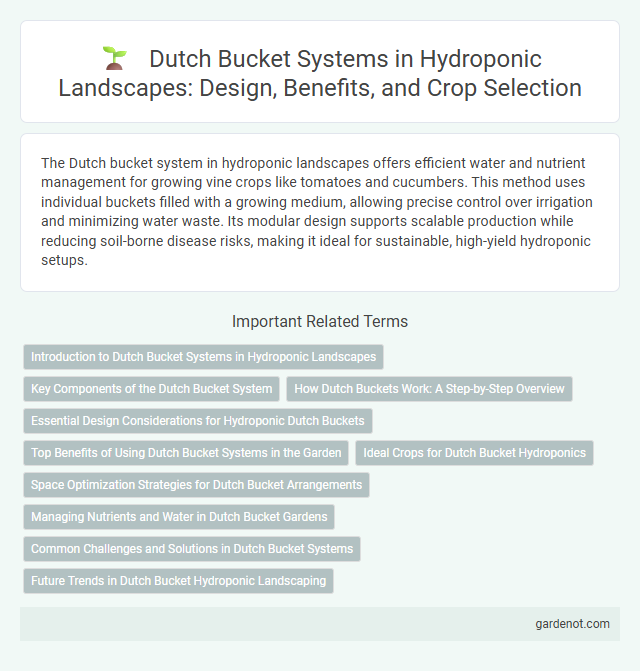The Dutch bucket system in hydroponic landscapes offers efficient water and nutrient management for growing vine crops like tomatoes and cucumbers. This method uses individual buckets filled with a growing medium, allowing precise control over irrigation and minimizing water waste. Its modular design supports scalable production while reducing soil-borne disease risks, making it ideal for sustainable, high-yield hydroponic setups.
Introduction to Dutch Bucket Systems in Hydroponic Landscapes
Dutch bucket systems in hydroponic landscapes utilize a modular container setup designed for efficient water and nutrient delivery to individual plants, optimizing growth in controlled environments. Each bucket supports a single plant, allowing precise control of water, nutrient flow, and aeration, which enhances root health and maximizes yield. This system is particularly favored for growing vine crops such as tomatoes, cucumbers, and peppers in both commercial and research hydroponic applications.
Key Components of the Dutch Bucket System
Key components of the Dutch bucket system include durable buckets made from high-density polyethylene that serve as plant containers, a drip irrigation line to deliver nutrient-rich water directly to the roots, and an efficient drainage system that recycles excess solution back to the reservoir. Each bucket is equipped with a growing medium like coconut coir or perlite to support plant roots and facilitate proper aeration. The system also integrates a reservoir, submersible pump, and filtration unit to maintain consistent nutrient levels and pH balance essential for optimal plant growth.
How Dutch Buckets Work: A Step-by-Step Overview
Dutch buckets operate through a recirculating hydroponic system where nutrient-rich water is delivered to each bucket containing a plant. Water flows from a central reservoir into each bucket, saturating the grow media and providing essential nutrients directly to the roots before draining back into the reservoir for reuse. This efficient water management reduces waste and supports healthy plant growth by maintaining consistent moisture and nutrient levels.
Essential Design Considerations for Hydroponic Dutch Buckets
Essential design considerations for hydroponic Dutch buckets include selecting the appropriate bucket size, typically 5 gallons, to balance root space and nutrient solution volume, ensuring optimal plant growth. Proper spacing between buckets, usually 12 to 18 inches, promotes air circulation and light penetration, reducing disease risk. A reliable drainage system with PVC piping and emitters is crucial for recirculating nutrient solutions, maintaining consistent moisture levels, and preventing waterlogging.
Top Benefits of Using Dutch Bucket Systems in the Garden
Dutch bucket systems optimize water and nutrient delivery through recirculation, reducing waste in hydroponic gardens. They provide exceptional root aeration and space efficiency, allowing for high-density plant growth, especially for vine crops like tomatoes and cucumbers. The modular design supports scalability and easy disease management, enhancing overall crop yield and health.
Ideal Crops for Dutch Bucket Hydroponics
Dutch bucket hydroponics thrives with high-value, fruiting crops such as tomatoes, peppers, cucumbers, and eggplants, which benefit from precise nutrient and water management. Leafy greens and herbs like basil and mint can also perform well but typically require less space and support than vining crops. The system's design optimizes aeration and drainage, making it ideal for plants with moderate to high water uptake and sensitivity to root diseases.
Space Optimization Strategies for Dutch Bucket Arrangements
Dutch bucket systems maximize space efficiency by vertically stacking buckets and aligning rows in tight, parallel formations to reduce footprint while maintaining accessibility. Implementing adjustable rack heights and modular components allows customization to plant size and growth stages, boosting yield per square meter. Strategic bucket spacing optimizes air circulation and light penetration, essential for healthy root development and uniform crop growth.
Managing Nutrients and Water in Dutch Bucket Gardens
Managing nutrients and water in Dutch bucket gardens involves maintaining precise control over the nutrient solution to ensure optimal plant growth and yield. Efficient recirculation systems minimize water waste while maintaining balanced pH levels and electrical conductivity (EC) within the 1.5-2.5 mS/cm range. Regular monitoring and adjustment of nutrient concentration prevent deficiencies and toxicities, improving crop health in hydroponic landscapes.
Common Challenges and Solutions in Dutch Bucket Systems
Dutch bucket systems often face challenges such as nutrient imbalances, waterlogging, and root diseases due to limited drainage and recirculation. Implementing precise nutrient management with automated dosing systems and ensuring proper bucket spacing enhance aeration and prevent water stagnation. Regular cleaning protocols and integrating beneficial microbes effectively reduce pathogen buildup, promoting healthier root development.
Future Trends in Dutch Bucket Hydroponic Landscaping
Future trends in Dutch bucket hydroponic landscaping emphasize automation integration and sustainable resource management to boost crop yields and reduce environmental impact. Innovations include sensor-driven nutrient delivery systems and AI-based climate control that optimize plant growth conditions. Expansion of urban agriculture leveraging vertical Dutch bucket setups is expected to enhance food security and promote green urban spaces.
Dutch bucket site Infographic

 gardenot.com
gardenot.com